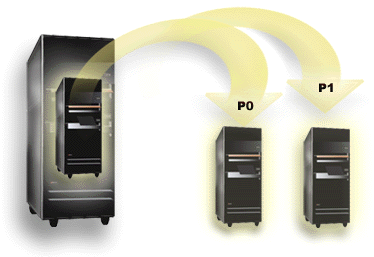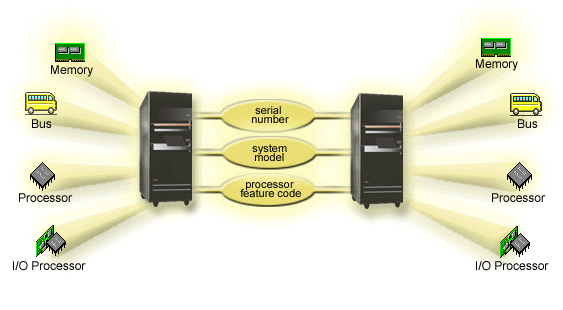Understand the meaning of a logical partitioned system and how primary and secondary partitions operate as independent servers.

Logical partitioning is the ability to make an iSeries™ server run as if it were two or more independent servers. Each logical partition operates as an independent logical server. However, each partition shares a few physical system attributes such as the system serial number, system model, and processor feature code. All other system attributes may vary among partitions.
Logical partitions fall into two categories, primary partitions or secondary partitions. Each logically partitioned system has one primary partition and one or more secondary partitions. The primary partition is the only partition prior to performing any configuration changes on a system. Before secondary partitions are created, all system resources are assigned to the primary partition. Secondary partitions are independent of each other. While each secondary partition maintains a dependency on the primary, it otherwise operates as a stand-alone server.
All management functions for partitions are integrated into the Licensed Internal Code of the primary partition.
When you perform a restart of the primary partition on a server with multiple partitions, the primary partition starts first. The primary partition owns certain system resources (the system operation panel, service processor, and system key lock). The primary partition can start (IPL) secondary partitions once the system validates these resources. If a processor, memory card, or system bus failure occurs, you can find system error log entries in the primary partition Product Activity Log.
The primary partition, essentially the partition manager for your server, must remain active for the secondary partitions to be active. It is important to plan carefully on how you operate the primary partition or the types of workload you run in the primary partition. For example, i5/OS™ commands such as Power Down System (PWRDWNSYS), operator panel functions such as 3, 8, or 22, applying fixes (PTFs) that require a restart will affect all of the secondary partitions. You may want to restrict the primary partition to simple partition management tasks only. Since all logical partition resource movement is achieved through use of the primary partition, the isolation of the primary partition provides a secure environment whereby users in secondary partitions are not able to move resources such as processor or memory without going through a logical partition administrator of the primary partition. Where primary partition isolation is not possible, you may want to think about implementing applications that require little or no maintenance, by not using it as a test partition.
Each logical partition represents a division of resources in your iSeries server. Each partition is logical because the division of resources is virtual, not along physical boundaries. The primary resources in your server are its processors, memory, buses, and IOPs. The following diagram shows the division of system resources on a server that has two partitions:
